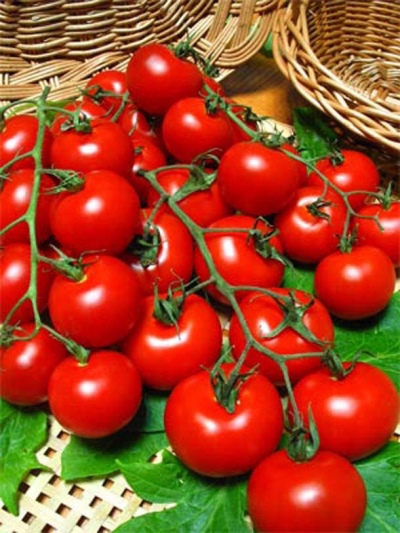
- Authors: Kudryavtseva G.A., Fotev Yu.V., Kotelnikova M.A., Kondakov S.N.
- Year of approval: 2008
- Category: grade
- Growth type: indeterminate
- Appointment: fresh consumption, for whole fruit preservation
- Ripening period: mid-season
- Ripening time, days: 115-117
- Growing conditions: for open ground, for film greenhouses
- Marketability: high
- Bush size: tall
Tomato is one of the most popular vegetables because it is delicious and healthy. It can be planted in a vegetable garden, greenhouse and even on a balcony. Tomato Necklace red must be properly grown in order for it to bring the appropriate harvest.
Description of the variety
The tall plant can be planted in open ground and greenhouses. Refers to indeterminate varieties. The fruits are served fresh on the table and canned whole.
The height of the bushes is up to 170 cm, branching is assessed as moderate. The foliage grows medium in size, green in color.
The inflorescences are complex, there is an articulation.
The main qualities of the fruit
The fruits are highly marketable, which means that they have an attractive appearance. In an immature state they are green, in a ripe state they are red.
It is cherry in size, weighing up to 7 grams. In shape, the tomatoes are cherry-shaped, rounded. Up to 20 tomatoes can be formed on one brush.
The pulp is medium in density, very tender and juicy. The skin is smooth.
Taste characteristics
The fruits of the Red Necklace have a pronounced sweetness.
Ripening and fruiting
The variety is classified as mid-season. From the moment of planting the seedlings to the collection of fruits, it takes up to 117 days. The fruits are harvested gradually as they ripen.
Yield
The red necklace is a high-yielding tomato, you can get up to 3.2 kg of fruit per square meter.
The timing of planting seedlings and planting in the ground
In March, it is recommended to plant seeds for seedlings, after 60-65 days the plants can be transferred to the ground.

Growing tomato seedlings is an extremely important process, because it largely depends on whether the gardener will be able to harvest at all. All aspects must be taken into account, from seedbed preparation to planting in the ground.
Landing scheme
When planting the Red Necklace, a 40x40 cm scheme is used.

Growing and care
The tomato requires garters on trellises or stakes. Formation is also necessary, leaving 1 or 2 stems.
Tomatoes in this variety have high nutritional requirements, so they grow best in fertile and well-drained soils. They should not be planted after vegetables of the nightshade family, as there is a high risk of transmission of common fungal diseases, including "potato plague" - late blight.
For growing tomatoes, the Red Necklace is suitable as a top dressing for rotted manure, which is introduced into the soil in the fall or two years earlier. Before planting, the soil should also be saturated with mineral fertilizers, including potassium and phosphorus fertilizers. The use of nitrogen is necessary only at the beginning of the growing season.
After planting, tomatoes need to be regularly looked after, systematically watered (avoiding wetting the leaves) and weeds removed. Watering is carried out exclusively at the root.If this is a greenhouse cultivation, drip irrigation can be arranged. The soil should not be over-moistened, as this negatively affects the quality of the fruits and the root system.
For this type, it is necessary to install the appropriate supports. The bushes are tied to them with a rope, plastic clamps so that the shoots do not bend and break under the weight of the fruit.
All excess shoots are removed. This process is called pinning. The bush does not need extra shoots, since they pull on nutrients, overload the plant, but do not produce high-quality fruits.
Removing the lower leaves is also necessary, since they are the first to become infected with fungal spores on the bush.




A plant needs different micronutrients at each stage of growth. All fertilizers can be divided into two groups: mineral and organic. Folk remedies are often used: iodine, yeast, bird droppings, eggshells.
It is important to observe the rate and period of feeding. This also applies to folk remedies and organic fertilizers.
Disease and pest resistance
The red necklace has no resistance to diseases and pests, so you need to regularly process tomatoes. At the first stages of development, it is worth using copper sulfate, then commercial fungicides. They will rid the plant of powdery mildew, scab and other diseases.
Insecticides, including soap solution, help from aphids and spider mites. Garden oils can be used, the most commonly used is neem oil.


Resistant to adverse weather conditions
Red necklace - cold-resistant and stress-resistant variety.
Growing regions
It can be grown in most regions of our country, including in the south, middle lane and even in the north in greenhouses.

























































































